First of all, we are all up way too late and our parent''s are gonna be really p......sed! Back to the topic; diamonds face up best under natural lightiing. If you are viewing a diamond under spot/track lightiing, do not make a judgement as to it''s cut quality! These types of lighting will make a poorly cut gem give off a false, unnatural sparkle. You must view the diamond in an environment that simulates natural sunlight.( a combination of incandescent and flourescent) Do not be deceived by hot showroom track lighting!
You are using an out of date browser. It may not display this or other websites correctly.
You should upgrade or use an alternative browser.
You should upgrade or use an alternative browser.
How lighting can influence on grade appearance
- Thread starter Serg
- Start date
- Status
- Not open for further replies. Please create a new topic or request for this thread to be opened.
Re: Secondly, that cut is not used to enhance color for a colored stone. It may enhance the brilliance of the stone, but it doesn't enhance the actual color as you put it. I have never heard of anyone using that particular cut to "enhance" the color of any stone.
Joe,
All stones had been cut from one piece CZ( one absorption spectrum) .
I hope we have chance to do report about our color work on GIA Gemological Research Conference in August 2006.
If we will do such report , you welcome. We can discuss Portuguesse round cuts for diamond on conference,
Now please return to my examples and questions.
Joe,
It is very funny.
I published photos from our ( My and Yuri) work: ’Variation ranges of fancy colored diamonds color appearance and how it depend on cut and lighting conditions’
All stones had been cut from one piece CZ( one absorption spectrum) .
I hope we have chance to do report about our color work on GIA Gemological Research Conference in August 2006.
If we will do such report , you welcome. We can discuss Portuguesse round cuts for diamond on conference,
Now please return to my examples and questions.
- Joined
- Sep 3, 2000
- Messages
- 6,758
Serg: I hear you. Of course, finding the cut parameters of what makes a diamond darker in regular lighting is very valuable for fancy color diamond development. If that is part of the context of your discussion, then I am certainly on your side of such findings. In time we will understand how to best cut bright, sparkly diamonds AND how to cut the richest color appearing fancy color diamonds.....
This is a field I have not worked on and I am glad someone is. It is another area where true knowledge of how to best cut diamonds is lacking using a scientific approach.
This is a field I have not worked on and I am glad someone is. It is another area where true knowledge of how to best cut diamonds is lacking using a scientific approach.
This discussion is far too technical for me to make any meaningful contribution since I have no expertise. I only know what looks like a beautiful diamond to me and what does not. I am sure there are nuances in brightness, scintillation, fire, cut, etc. that I would never pick up on when I see a stone. I either like it or I don''t. I would never make a decision bsed on my own observations and when I selected my stone, I went by the advice of experts--Brian at Whiteflash and a professional appraiser.
However, I am totally confused about the elaborate explanation of Portugeese or brilliant cut and how to look for one. Do I now understand correctly that this has little to do with diamonds and has nothing to do with the explanation for the question I asked above--that in one lighting condition my friend''s ring looked whiter and nicer than mine. Yet when I saw her ring and mine in a different lighting environment, her ring looked only slightly whiter and mine was brighter and more sparkly.
If the fact that one may be a Portugeese cut is probably not applicable, is there an answer or is my observation not on target with the discussion and therefore worthless?
However, I am totally confused about the elaborate explanation of Portugeese or brilliant cut and how to look for one. Do I now understand correctly that this has little to do with diamonds and has nothing to do with the explanation for the question I asked above--that in one lighting condition my friend''s ring looked whiter and nicer than mine. Yet when I saw her ring and mine in a different lighting environment, her ring looked only slightly whiter and mine was brighter and more sparkly.
If the fact that one may be a Portugeese cut is probably not applicable, is there an answer or is my observation not on target with the discussion and therefore worthless?
Dave,
re: Of course, finding the cut parameters of what makes a diamond darker in regular lighting is very valuable for fancy color diamond development
not for fancy color only, It is very important for cut grading D-Z diamonds by new GIA cut grading system.
Color is necessary for more simple tracking some reason of phenomena only. I sure You can find such examples for D color diamonds too .
re: Of course, finding the cut parameters of what makes a diamond darker in regular lighting is very valuable for fancy color diamond development
not for fancy color only, It is very important for cut grading D-Z diamonds by new GIA cut grading system.
Color is necessary for more simple tracking some reason of phenomena only. I sure You can find such examples for D color diamonds too .
Dear serge,Date: 1/14/2006 7:55:08 AM
Author: Serg
Solange,
If you want receive good explanation your experience , You need informed correctly about all detailes such: Light conditions( include clothes...), 3d models both diamond, type of rings, how clear was both diamonds,... I think it is not possible. If your diamond has more life, be happy.
Thank you for your concise response which was to the pont and not too complicated for a novice like me to understand.
i guess i was overwhelmed by the information about the Portugeese cut as an explanation. Yours makes far more sense to a novice like me and is probably all the information I needed without technical information beyond my comprehension.
I just wanted to clear up the confusion about the Portugeese cut and whether I should have llooled into this before buying a stone. Obviously it is not relevant to the question I asked and I appreciate your taking the time to give me information that I can understand and an explanation as to factors which I cannnot possibly obtain.
The discussion you started is very interesting and I will follow it in the hope that I will learn from it even though I do not have the expertise to understand the experts, including you, who have contributed to the further studies and education of others.
I think the Portugeese cut just added confusion to an otherwise scholarly and fascinating discussion by experts and I hope you will be successful in your qust for further studies by the experts named.
Thank you again for the simple, clear answer..
mdx
Brilliant_Rock
- Joined
- Mar 1, 2002
- Messages
- 570
Hi Serg
Here is something interesting to consider, may be a bit off track and not too scientific.
In this line of thought I eliminate discussion on the Princess cuts as just poor design.
Let us now consider that transparent (white) diamonds may behave exactly the same as your examples of colored diamonds.
In other words what we are seeing in your two images is an exaggeration of the effect due to the color saturation (reduction in transparency)
The human eyes easily see the difference in the colored stone but cannot pickup the difference in a transparent stone. (well cut stone)
What if cut quality goes done, will it become more visible using Serg’s model.
Could we also say that as color goes down from D, the effects of lighting change increases?
Serg perhaps running the same test with only round brilliants using known good performers and a range of poor cuts could be interesting
Johan
- Joined
- Aug 15, 2000
- Messages
- 19,235
So let me ask some questions Sergey so that I can work out what you are thinking?Date: 1/14/2006 6:26:12 AM
Author: Serg1) First is similar to ''Office type'' with white walls and big windows with white textile jalousie (jalousie = venetian or slat blinds). Stones is inside Magna color scope ( Eickhorst company) . Position viewer, stones, light are like in GIA DiamondDock Viewing Environment ( but distance between stones, background and light shorter. because Magna color scope has smaller height. BTW This phenomena strongly depends from such distance. Light in Greta color scope turn off
2) Second . Same + light turn on.
1. the Eickhorst Magna color scope lighting box is probably like the old one from GIA in these 2 photo''s?
2. there are 2 light sources in this box - the one used in the first image is a soft flood, and the Greta one (do you mean ''greater'') is much much brighter?
3. or the first photo is with no light at all - just the ambient room light?
So perhaps the effect you have noticed is like what we see when we view a diamond in direct sunlight? We know that makes a good diamond look very dark with only a few very bright flashes.
Do you think GIA made this mistake - that the light is a little too close and to direct - and this makes worse diamonds look better?
You know that I think the ambient room light in the background is probably way to dim to create any effect. I have tried to model what this GIA light is like in DiamCalc and it shows shallow stones very very badly.
Can you show us an image of the eickhorst system with a scale or a person for relativity?
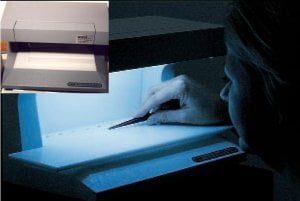
re:Author: Serg1) First is similar to ''Office type'' with white walls and big windows with white textile jalousie (jalousie = venetian or slat blinds). Stones is inside Magna color scope ( Eickhorst company) . Position viewer, stones, light are like in GIA DiamondDock Viewing Environment ( but distance between stones, background and light shorter. because Magna color scope has smaller height. BTW This phenomena strongly depends from such distance. Light in Greta color scope turn off
2) Second . Same + light turn on.
Sorry for misprint.
1) First is similar to ''Office type'' with white walls and big windows with white textile jalousie (jalousie = venetian or slat blinds). Stones is inside Magna color scope ( Eickhorst company) . Position viewer, stones, light are like in GIA DiamondDock Viewing Environment ( but distance between stones, background and light shorter. because Magna color scope has smaller height. BTW This phenomena strongly depends from such distance. Light in Magna color scope turn off
2) Second . Same + light turn on.
Johan, I think color is not important at all ( transparency is important of course.) Stone in my examples has very good transparency.
Garry, Johan
This example is very important because : Round go to dark but Princess is similar . In direct sun light all diamonds go to dark. This example shows the problem GIA study, Sun light does not show this problem
- Joined
- Aug 15, 2000
- Messages
- 19,235
Stones are facing observer / camera, and the bright light from 1 tube is coming from about 40 degrees relative to the observer / camera line of sight.
The round diamond perhaps can only collect light from a very small number of facets (see the ETAS for 6mm ideal stone).
The princess cut can gather many more small amounts of light from that direction - but many will be too small for human eye to resolve / pixcel size for camera.
Sergey does the eye see the same lighter princess body color as the camera shows?
The round diamond perhaps can only collect light from a very small number of facets (see the ETAS for 6mm ideal stone).
The princess cut can gather many more small amounts of light from that direction - but many will be too small for human eye to resolve / pixcel size for camera.
Sergey does the eye see the same lighter princess body color as the camera shows?
- Joined
- Aug 15, 2000
- Messages
- 19,235
- Joined
- Aug 15, 2000
- Messages
- 19,235
rerincess cut - or other not so good cut diamonds can look better than round in GIA type lighting?
Yes.
And even more : NOT GOOD cut can look better than VERY good cut in GIA type lighting.
Reasons:
1) Too much bright background( Brightness background strongly depends from distance between background and Lamp, Brightness diamond does not strongly depends from distance between diamond and light. In normal viewer conditions such distance is much shorter)
2) A lot of ( may be most) light go from pavilion side . In normal viewer conditions light do from crown side
Good diamond is darker in such conditions. Diamond with leakage has compensation from direct light and background , diamond without leakage has not such compensation.
- Joined
- Sep 19, 2004
- Messages
- 2,547
To consider 3 type semi Spheres
1) Center of SemiSphera is in direction center diamond to center crown: Crown SemiSphera
2) Center of SemiSphera is in direction center diamond to Culet: Pavilion SemiSphera
3) Center of SemiSphera is in direction center diamond to girdle: Girdle SemiSphera
In normal viewer condition diamond work with Crown SemiSphera / All try optimize cut for perfect work with light from this SemiSphera.
Pavilion SemiSphera is helpful to catch leakage
I hope this explanation is more clear
1) Center of SemiSphera is in direction center diamond to center crown: Crown SemiSphera
2) Center of SemiSphera is in direction center diamond to Culet: Pavilion SemiSphera
3) Center of SemiSphera is in direction center diamond to girdle: Girdle SemiSphera
In normal viewer condition diamond work with Crown SemiSphera / All try optimize cut for perfect work with light from this SemiSphera.
Pavilion SemiSphera is helpful to catch leakage
In GIA DiamondDock™ Viewing Environment work part Girdle SemiSphera with very big brightness. Such big brightness block up any other light in room( include light from very important direction for classical round diamonds)
I hope this explanation is more clear
Important remark.
I didn''t say that lighting Magha Scope is equivalent of GIA DiamondDoc Viewing Environment. Of course they are different. Above all they have different distances between diamond and light source.
I am displaying the problem in lighting GIA DiamondDock Viewing Environment with help of lighting Magha Scope, in which this problem is more clear.
In spite of more weak display of this problem in GIA Scope it presents there and strongly influence on mutual arrangement of cut grades, getting by diamonds.
I didn''t say that lighting Magha Scope is equivalent of GIA DiamondDoc Viewing Environment. Of course they are different. Above all they have different distances between diamond and light source.
I am displaying the problem in lighting GIA DiamondDock Viewing Environment with help of lighting Magha Scope, in which this problem is more clear.
In spite of more weak display of this problem in GIA Scope it presents there and strongly influence on mutual arrangement of cut grades, getting by diamonds.
- Joined
- Aug 15, 2000
- Messages
- 19,235
If I understand correctly - this all lines up with my ideas too.Date: 1/16/2006 3:41:27 AM
Author: Serg
GH translation
To consider 3 different hemispherical lighting directions
1) Center of a normal hemisphere - one that is directly above the table / crown - call it the Crown hemisphere
2) Center of hemisphere below the diamond: The Pavilion hemisphere - it is useful to light the diamond from below to show leakage
3) A new type of HemiSphere - the center of the hemisphere is located at the normal horizon - facing the girdle - light is shining on the crown from 45 degrees - and also on the pavilion to 45 degrees: The Girdle Hemisphere
It is normal to work with the Crown HemiSphere to optimize cut for light from this direction - allowing for a central dark area for observer obstruction.
What sergey is saying is, however, that the GIA DiamondDock™ Viewing Environment adds a lot of Girdle hemiSphere brightness from the upper area of the stone we are observing. This big brightness blocks or washes out any other light in room, including light from the normally very important crown hemisphere direction.
The light tray has more leakage illumination from a deep stone than a shallow one - so it favours leaking stones by returning light.
The light that comes from about 40-45 degrees to the stone creates a lot of leakage. this leakage would create a general glow in the opaque perspex tray that could be seen as a relative bright area in addition to any partial direct non leakage return- and that should provide contrast against the dark star from the relative darkenss of the observers face.
light is coming to the stone from the back wall reflected off the lights above and perhaps this is entering the stone from both pavilion and crown side.
Date: 1/16/2006 5:59:05 AM
Author: Serg
Important remark.
I didn''t say that lighting Magha Scope is equivalent of GIA DiamondDoc Viewing Environment. Of course they are different. Above all they have different distances between diamond and light source.
I am displaying the problem in lighting GIA DiamondDock Viewing Environment with help of lighting Magha Scope, in which this problem is more clear.
In spite of more weak display of this problem in GIA Scope it presents there and strongly influence on mutual arrangement of cut grades, getting by diamonds.
Such Rank(mutual arrangement) for round cut is strongly depends from angle between table diamond and Horizon also.
You can understand it by raytracing in DC easy/ Check such angle in range 30-45 degree and pavilion angle in range 40-41.
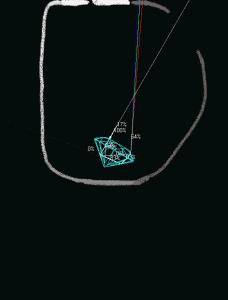
belle
Super_Ideal_Rock
- Joined
- Nov 19, 2004
- Messages
- 10,285
strmrdr
Super_Ideal_Rock
- Joined
- Nov 1, 2003
- Messages
- 23,295
serg,
I find a tilt with over head lighting highly consistant with how people view diamonds in the real world on the finger.
I did a small study and asked 20 people to look at there diamonds and admire them.
Every last one of them tilted there hand back towards them, so the viewing position was over head lighting, diamond tilted, some did it at full arm lenth some at half.
Not one brought it in to there body and looked at it strait down.
I find a tilt with over head lighting highly consistant with how people view diamonds in the real world on the finger.
I did a small study and asked 20 people to look at there diamonds and admire them.
Every last one of them tilted there hand back towards them, so the viewing position was over head lighting, diamond tilted, some did it at full arm lenth some at half.
Not one brought it in to there body and looked at it strait down.
belle
Super_Ideal_Rock
- Joined
- Nov 19, 2004
- Messages
- 10,285
this is the reason that i have a hard time with the idea that certain shallow stones, due to obscuration, are better for pendants than rings. i believe that for the most part, rings are viewed with the hand held out. there is no obscuration.Date: 1/16/2006 11:40:04 AM
Author: strmrdr
serg,
I find a tilt with over head lighting highly consistant with how people view diamonds in the real world on the finger.
I did a small study and asked 20 people to look at there diamonds and admire them.
Every last one of them tilted there hand back towards them, so the viewing position was over head lighting, diamond tilted, some did it at full arm lenth some at half.
Not one brought it in to there body and looked at it strait down.
- Joined
- Aug 15, 2000
- Messages
- 19,235
- Joined
- Feb 26, 2003
- Messages
- 379
I find a tilt with overhead lighting highly consistent with how people view diamonds in the real world on the finger. Every last one of them tilted their hand back towards them, so the viewing position was over head lighting, diamond tilted, some did it at full arm length some at half. strmrdr
This is the reason that i have a hard time with the idea that certain shallow stones, due to obscuration, are better for pendants than rings. I believe that for the most part, rings are viewed with the hand held out. There is no obscuration. Belle
The amount of head obstruction varies with the distance from the eye to the diamond. For each eye taken separately, it also varies from a minimum on the side of the head nearest the eye to a maximum on the top of the head or the far side of the head from the eye. Below the eye there is obstruction by the chin, neck and torso that is greater still.
See the head obstruction example on my informational website at http://www.acagemlab.com/news/twocolfireart2.htm which I have included here. This is an example diamond illumination by bright, overcast, sky light, partially obstructed by my silhouette.
Far from being a circular head obstruction, at a distance of 25cm, the obstruction to the right of the right eye is only 11 degrees while it is about 25 degrees to the left of the right eye. (I inserted the Cyborg eye close to the position of my dominant right eye.)
I note the amazing, and perhaps not coincidental, resemblance of my silhouette to the Muppet, scientist’s assistant, Beaker.
Please consider that, from the perspective of each eye, there is this varying, asymmetrical head obstruction around the zero degree line of sight.
Michael Cowing
www.acagemlab.com
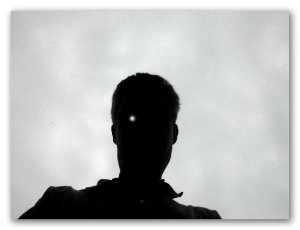
This is the reason that i have a hard time with the idea that certain shallow stones, due to obscuration, are better for pendants than rings. I believe that for the most part, rings are viewed with the hand held out. There is no obscuration. Belle
For the sake of clarity it is most convenient to refer to the angle of the illumination relative to the "line of sight" between the viewer''s eye and the diamond. All the lighting may be identified as to its angular location relative to this line of sight.
The face-up or ''normal'' view of the diamond has the table perpendicular to this line of sight. Whether we look down at the diamond on our finger or tilt our hand back toward our head, as strmrdr indicates is most common, we still look at the diamond face toward our eye which is zero degrees. Of course we tilt the diamond around as well, but the important view when carefully examining the diamond''s beauty centers on the ''normal to the table'' line of sight view.
With the hand held out and tilted back toward the viewer''s line of sight, or with the observer looking down and the diamond face-up toward both the viewer and the sky, most of the light reflected to the observer from a round brilliant cut is gathered from within 45 degrees of the line of sight. By definition, there is always head obstruction of a variable amount around zero degrees. (Unless you are Zippy the Pinhead)
The amount of head obstruction varies with the distance from the eye to the diamond. For each eye taken separately, it also varies from a minimum on the side of the head nearest the eye to a maximum on the top of the head or the far side of the head from the eye. Below the eye there is obstruction by the chin, neck and torso that is greater still.
See the head obstruction example on my informational website at http://www.acagemlab.com/news/twocolfireart2.htm which I have included here. This is an example diamond illumination by bright, overcast, sky light, partially obstructed by my silhouette.
Far from being a circular head obstruction, at a distance of 25cm, the obstruction to the right of the right eye is only 11 degrees while it is about 25 degrees to the left of the right eye. (I inserted the Cyborg eye close to the position of my dominant right eye.)
I note the amazing, and perhaps not coincidental, resemblance of my silhouette to the Muppet, scientist’s assistant, Beaker.
Please consider that, from the perspective of each eye, there is this varying, asymmetrical head obstruction around the zero degree line of sight.
Michael Cowing
www.acagemlab.com

- Joined
- Aug 15, 2000
- Messages
- 19,235
I take it that was a general education post Michael?Date: 1/16/2006 8:59:18 PM
Author: michaelgem
I find a tilt with overhead lighting highly consistent with how people view diamonds in the real world on the finger. Every last one of them tilted their hand back towards them, so the viewing position was over head lighting, diamond tilted, some did it at full arm length some at half. strmrdr
This is the reason that i have a hard time with the idea that certain shallow stones, due to obscuration, are better for pendants than rings. I believe that for the most part, rings are viewed with the hand held out. There is no obscuration. Belle
For the sake of clarity it is most convenient to refer to the angle of the illumination relative to the ''line of sight'' between the viewer''s eye and the diamond. All the lighting may be identified as to its angular location relative to this line of sight.
The face-up or ''normal'' view of the diamond has the table perpendicular to this line of sight. Whether we look down at the diamond on our finger or tilt our hand back toward our head, as strmrdr indicates is most common, we still look at the diamond face toward our eye which is zero degrees. Of course we tilt the diamond around as well, but the important view when carefully examining the diamond''s beauty centers on the ''normal to the table'' line of sight view.
With the hand held out and tilted back toward the viewer''s line of sight, or with the observer looking down and the diamond face-up toward both the viewer and the sky, most of the light reflected to the observer from a round brilliant cut is gathered from within 45 degrees of the line of sight. By definition, there is always head obstruction of a variable amount around zero degrees. (Unless you are Zippy the Pinhead)
The amount of head obstruction varies with the distance from the eye to the diamond. For each eye taken separately, it also varies from a minimum on the side of the head nearest the eye to a maximum on the top of the head or the far side of the head from the eye. Below the eye there is obstruction by the chin, neck and torso that is greater still.
See the head obstruction example on my informational website at http://www.acagemlab.com/news/twocolfireart2.htm which I have included here. This is an example diamond illumination by bright, overcast, sky light, partially obstructed by my silhouette.
Far from being a circular head obstruction, at a distance of 25cm, the obstruction to the right of the right eye is only 11 degrees while it is about 25 degrees to the left of the right eye. (I inserted the Cyborg eye close to the position of my dominant right eye.)
I note the amazing, and perhaps not coincidental, resemblance of my silhouette to the Muppet, scientist’s assistant, Beaker.
Please consider that, from the perspective of each eye, there is this varying, asymmetrical head obstruction around the zero degree line of sight.
Michael Cowing
www.acagemlab.com
You were not drawing any conclusions?
The link to your article is also ''background''?
Do you have an opinion on Sergey''s initial Quizz - that considers the situation where very bright light changes our eye adaption and can make diamonds lit from a narrow very bright area appear to have more contrast than they might in most other lighting formats.
(I hope that is part of what you are saying Sergey?)
This image takes yous and shows where the light appears to be coming from
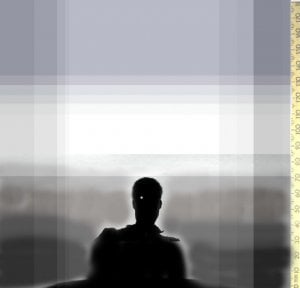
- Joined
- Aug 15, 2000
- Messages
- 19,235
So what we have is somewhat like a dome like these pictured in GIA''s Foundation Article.
1. The diamond is tilted about 35 degrees to face the observer
2. who is looking thru a black hole (they used 45 degrees of blackness) that is face to the diamond (35 degrees away from the top)
3. the light is coming in a Cosine or even more heavily weighted fashion (i.e. it is dark at the horizon and very much brighter at the top of the dome.
So Belle this is what you would see if you held the stone 6 inches from your face on a 35 degree tilt with a fluoro light just above and infront of you in a window less room with gray ceiling and walls that shade down to black.
Hmmm
Guess what?
Steep deep diamonds look best in that environment, and shallow stones look awful.
So far the onlky saving grace that I can spot for GIA''s study is that stereo vision somewhat lessens leakage.
But there are 2 problems here too:
1. As storm says - we are dominant eye driven (I do not agree entirely with that - especially regards fire ans scintillation / sparkles)
2. if the tray is lighting up and glowing more from diamonds that leak more, then the more a diamond leaks - the brighter the leakage areas appear
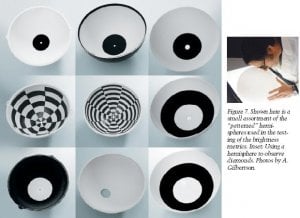
1. The diamond is tilted about 35 degrees to face the observer
2. who is looking thru a black hole (they used 45 degrees of blackness) that is face to the diamond (35 degrees away from the top)
3. the light is coming in a Cosine or even more heavily weighted fashion (i.e. it is dark at the horizon and very much brighter at the top of the dome.
So Belle this is what you would see if you held the stone 6 inches from your face on a 35 degree tilt with a fluoro light just above and infront of you in a window less room with gray ceiling and walls that shade down to black.
Hmmm
Guess what?
Steep deep diamonds look best in that environment, and shallow stones look awful.
So far the onlky saving grace that I can spot for GIA''s study is that stereo vision somewhat lessens leakage.
But there are 2 problems here too:
1. As storm says - we are dominant eye driven (I do not agree entirely with that - especially regards fire ans scintillation / sparkles)
2. if the tray is lighting up and glowing more from diamonds that leak more, then the more a diamond leaks - the brighter the leakage areas appear

- Joined
- Feb 26, 2003
- Messages
- 379
Hi Garry,
Re: I take it that was a general education post Michael?
You were not drawing any conclusions?
The link to your article is also ''background''?
This post was intended as a lot more than general education. It was meant to give everyone a way to look and speak about this problem from the perspective of the line of sight from the eye of the viewer to the diamond irrespective of whether he/she is looking staight down at the diamond or, as strmrdr says, "with the hand tilted back".
It was also intended to help Sergey communicate. It seemed like a good idea, as I read how strmrdr, Belle and others were grappling with Sergey''s message.
From your take, it does not sound like I was successful.
On a further note to Sergey, it would be most instructive to me and perhaps others, if you could photograph the two lighting circumstances with a wide angle lens, along the line of site, toward the observer''s eyes like my example, to give a picture of the illumination like Garry has tried to approximate.
It would then be easy to understand the performance of the diamond''s in the two lighting environments.
Alternatively, a shot of the whole setup from some side angle would also be helpful.
Michael Cowing
www.acagemlab.com
Re: I take it that was a general education post Michael?
You were not drawing any conclusions?
The link to your article is also ''background''?
This post was intended as a lot more than general education. It was meant to give everyone a way to look and speak about this problem from the perspective of the line of sight from the eye of the viewer to the diamond irrespective of whether he/she is looking staight down at the diamond or, as strmrdr says, "with the hand tilted back".
It was also intended to help Sergey communicate. It seemed like a good idea, as I read how strmrdr, Belle and others were grappling with Sergey''s message.
From your take, it does not sound like I was successful.
On a further note to Sergey, it would be most instructive to me and perhaps others, if you could photograph the two lighting circumstances with a wide angle lens, along the line of site, toward the observer''s eyes like my example, to give a picture of the illumination like Garry has tried to approximate.
It would then be easy to understand the performance of the diamond''s in the two lighting environments.
Alternatively, a shot of the whole setup from some side angle would also be helpful.
Michael Cowing
www.acagemlab.com
- Status
- Not open for further replies. Please create a new topic or request for this thread to be opened.
Share:
How Are Diamonds Made? Natural vs Lab-Created Explained How Are Diamonds Made? Natural vs Lab-Created Explained - 08/05
How Are Diamonds Made? Natural vs Lab-Created Explained - 08/05

Top Wedding Ring Brands for Every Style and Budget
Top Wedding Ring Brands for Every Style and Budget - 08/05
Where to Buy Lab Grown Diamonds: Best Places Compared
Where to Buy Lab Grown Diamonds: Best Places Compared - 08/05

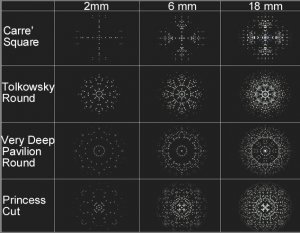
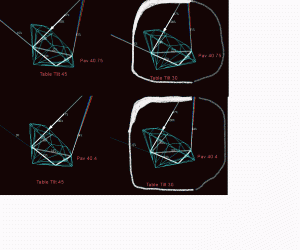

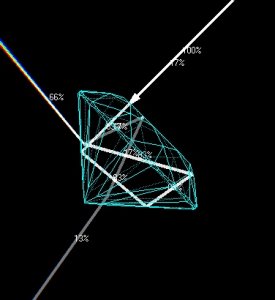

300x240.png)